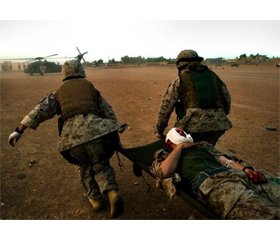Журнал «Медицина неотложных состояний» 8 (71) 2015
Вернуться к номеру
Особенности медицинской помощи раненым с тяжелой боевой травмой черепа и головного мозга
Авторы: Хитрый Г.П., Рабощук А.В. - Кафедра анестезиологии и реаниматологии Украинской военно-медицинской академии, г. Киев; Онищенко А.К. - Отделение реанимации и интенсивной терапии клиники нейрохирургии Национального военно-медицинского клинического ордена Красной Звезды центра «Главный военный клинический госпиталь» Министерства обороны Украины, г. Киев
Рубрики: Медицина неотложных состояний
Разделы: Клинические исследования
Версия для печати
У статті викладені особливості надання медичної допомоги пораненим з тяжкою бойовою травмою черепа та головного мозку на етапах медичної евакуації. Детально розглянуто завдання інтенсивної терапії в поранених з даною патологією, що проводиться на рівні спеціалізованої медичної допомоги з урахуванням сучасних підходів та стандартів.
В статье изложены особенности оказания медицинской помощи раненым с тяжелой боевой травмой черепа и головного мозга на этапах медицинской эвакуации. Подробно рассмотрены задачи интенсивной терапии у раненых с данной патологией, которая проводится на уровне специализированной медицинской помощи с учетом современных подходов и стандартов.
The article presents the features of the management of victims with severe combat traumatic brain injury on the stages of medical evacuation. The problem of intensive care of the wounded with this pathology, which is carried out at the stage of specialized medical care based on modern approaches and standards, is discussed in detail.
бойова травма черепа та головного мозку, етап медичної евакуації, інтенсивна терапія.
боевая травма черепа и головного мозга, этап медицинской эвакуации, интенсивная терапия.
combat traumatic brain injury, stage of medical evacuation, intensive care.
Статтю опубліковано на с. 80-82
Санітарні втрати у сучасних військових конфліктах характеризуються збільшенням питомої ваги поранених нейрохірургічного профілю [1]. Зокрема, за даними бюро медичної експертизи, причиною загибелі наших бійців під час АТО у 15,2 % стали поранення голови з руйнуванням головного мозку і переломами кісток черепа (тяжка черепно-мозкова травма (ЧМТ)) [2].
1. Военно-полевая хирургия локальных войн и вооруженных конфликтов / Под ред. Е.К. Гуманенко. — М.: ГЭОТАР-Медиа, 2011. — 672 с.
2. Андронатий В. У нас показатель смертности раненых на уровне последней компании США в Афганистане // Сайт rbc.ua. — 2014. — 17 ноября (http://www.rbc.ua/rus/interview/vitaliy-andronatiy-u-nas-pokazatel-smertnosti-ranenyh-17112014114800).
3. Malec J.F., Brown A.W., Leibson C.L., Flaada J.T., Mandrekar J.N., Diehl N.N., Perkins PK. The Mayo Classification System for Traumatic Brain Injury Severity // Journal of Neurotrauma. — 2007. — 24(9). — 1417-24.
4. World Health Organization. International statistical classification of diseases and related health problems. — 10th ed. — Geneva, Switzerland: World Health Organization, 1992.
5. TVSP Murthy. Secondary Brain Injury: prevention and Intensive Care Management // Indian Journal of Neurotrauma. — 2005. — Vol. 2, № 1. — Р. 7-12.
6. Chestnut R.M., Marshall S.B., Piek J. et al. Early and late systemic hypotension as a frequent and fundamental source of cerebral ischemia following severe brain injury in the Traumatic Coma Data Bank // Acta Neurochir. (Wien). — 1993. — 59 (Suppl.). — 121-5.
7. Свистов Д.В. Повреждения черепа и головного мозга / Д.В. Свистов // Указания по военно-полевой хирургии. — 2013. — С. 150-175.
8. Guidelines for the Management of Severe Traumatic Brain Injury. — 3rd ed. // J. Neurotrauma. — 2007.
9. Guidelines for the field management of combat-related head trauma / Brain Trauma Foundation — Disease Specific Society. — 2005.
10. Чаплик В.В. Невідкладна військова хірургія / Ред. В.В. Чаплик; пер. з англ. А. Кордіяк. — Львів: Наутілус, 2015. — 511 с.
11. Військова хірургія з хірургією надзвичайних ситуацій / За ред. В.Я. Білого. — Тернопіль: Укрмедкнига, 2004. — 324 с.
12. Severe Traumatic Brain Injury Management — Evidence Based-Medicine Guidelines / Orlando Regional Medical Center. — 2014.
13. Omert L.A. et al. Harbingers of poor outcome the day after severe brain injury: hypothermia, hypoxia, and hypoperfusion // J. Trauma. — 2003.
14. Rosner M.J., Daughton S. Cerebral perfusion pressure management in head injury // J. Trauma. — 1990. — 30. — 933-41.
15. Cruz J., Minoja G., Okuchi K. Improving clinical outcomes from acute subdural hematomas with the emergency preoperative administration of high doses of mannitol: arandomized trial // Neurosurgery. — 2001. — 49. — 864-71.
16. Cho M.Y., Shin J.H., Choi C.S., Ju M.B. The effect of barbiturate coma therapy // J. Koryo Gen Hosp. — 1991. — 14. — 149-154.
17. Gobiet W., Grote W., Bock W.J. The relation between intracranial pressure, mean arterial pressure and cerebral blood flow in patients with severe head injury // Acta Neurochir. (Wien). — 1975. — 32. — 13-24.
18. Wang H.E., Callaway C.W., Peitzman A.B., Tisherman S.A. Admission hypothermia and outcome after major trauma // Crit. Care Med. — 2005. — 33. — 1296-301.
19. Yates A.R., Dyke P.C. 2nd, Taeed R. et al. Hyperglycemia is a marker for poor outcome in the postoperative pediatric cardiac patient // Pediatr. Crit. Care Med. — 2006. — 7(4). — 351-355.
20. Annegers J.F., Hauser W.A., Coan S.P., Rocca W.A. A population-based study of seizures after traumatic brain injuries // N. Engl. J. Med. — 1998. — 338. — 20-24.
21. Bradshaw К., Smith М. Disorders of sodium balance after brain injury // Contin. Educ. Anaesth. Crit. Care Pain. — 2008. — 8(4). — 129-133.
22. Cole Ch.D., Gottfried O.N., Liu J.K., Couldwell W.T. Hyponatriemia in the neurosurgical patient: diagnosis and management // Neurosurg. Focus. — 2004. — 16(4). — Article 9.

